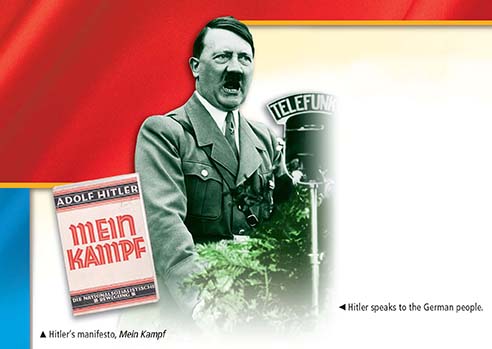SECTION 1: Dictators and War

▲ Hitler’s manifesto, Mein Kampf
WITNESS HISTORY  AUDIO
AUDIO
Hitler’s Brutal Determination
For the German dictator Adolf Hitler, war was an ennobling experience. War united a nation, demanded righteous sacrifices, and culminated in territorial acquisitions. Hitler believed that there was no morality in war, just victory and defeat. He instructed his generals:
“The victor will not be asked afterwards whether he told the truth or not. When starting and waging a war it is not right that matters, but victory. Close your hearts to pity. Act brutally. Eighty million people [Germans] must obtain what is their right. Their existence must be made secure. The stronger man is right.”
—Adolf Hitler, August 1939
Objectives
- Explain how dictators and militarist regimes arose in several countries in the 1930s.
- Summarize the actions taken by aggressive regimes in Europe and Asia.
- Analyze the responses of Britain, France, and the United States to the aggressive regimes.
Terms and People
- totalitarianism
- Joseph Stalin
- Benito Mussolini
- Adolf Hitler
- anti-Semitic
- Spanish Civil War
- appeasement
- Anschluss
- Munich Pact
NoteTaking
Reading Skill: Summarize As you read, summarize the actions in the 1930s of each of the countries listed in the table below.
| Soviet Union | Italy | Germany | Japan |
|---|---|---|---|
Why It Matters The effects of World War I and the Great Depression touched almost every corner of the world. In some countries, these upheavals led to the rise of a new kind of brutal dictatorship— the totalitarian state. Led by aggressive dictators, these states would destroy the peace established after World War I and spark a new, even deadlier, global conflict. Section Focus Question: Why did totalitarian states rise after World War I, and what did they do?
A Bitter Peace Unravels
In November 1918, World War I ended when Germany surrendered to the Allies. In 1919, delegates from 27 nations met in Versailles to hammer out a peace agreement, but only Britain, France, and the United States had a real say in most of the important decisions. Germany and Russia were not even present. From the first, many Germans resented the resulting Treaty of Versailles. Other nations also grumbled over the peace settlements. Italy and Japan, both Allies, had expected far more land for their sacrifices. The war that American President Woodrow Wilson had called “a war to end all wars” had left behind a mountain of bitterness, anger, frustration, and despair, often capped by a burning desire for revenge.
During the 1920s many nations, new and old, moved steadily toward democracy and freedom. Others, however, took the opposite direction, embracing repressive dictatorships and totalitarianism, a theory of government in which a single party or leader controls the economic, social, and cultural lives of its people. Throughout history




